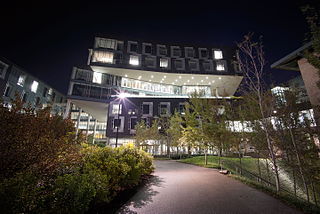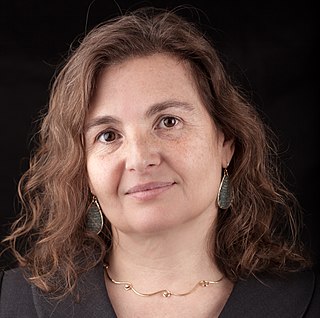
The School of Computer Science (SCS) at Carnegie Mellon University in Pittsburgh, Pennsylvania, US is a school for computer science established in 1988. It has been consistently ranked among the top computer science programs over the decades. As of 2022 U.S. News & World Report ranks the graduate program as tied for second with Stanford University and University of California, Berkeley. It is ranked second in the United States on Computer Science Open Rankings, which combines scores from multiple independent rankings.
Robotic mapping is a discipline related to computer vision and cartography. The goal for an autonomous robot is to be able to construct a map or floor plan and to localize itself and its recharging bases or beacons in it. Robotic mapping is that branch which deals with the study and application of ability to localize itself in a map / plan and sometimes to construct the map or floor plan by the autonomous robot.

Swarm robotics is an approach to the coordination of multiple robots as a system which consist of large numbers of mostly simple physical robots. ″In a robot swarm, the collective behavior of the robots results from local interactions between the robots and between the robots and the environment in which they act.″ It is supposed that a desired collective behavior emerges from the interactions between the robots and interactions of robots with the environment. This approach emerged on the field of artificial swarm intelligence, as well as the biological studies of insects, ants and other fields in nature, where swarm behaviour occurs.

An autonomous underwater vehicle (AUV) is a robot that travels underwater without requiring input from an operator. AUVs constitute part of a larger group of undersea systems known as unmanned underwater vehicles, a classification that includes non-autonomous remotely operated underwater vehicles (ROVs) – controlled and powered from the surface by an operator/pilot via an umbilical or using remote control. In military applications an AUV is more often referred to as an unmanned undersea vehicle (UUV). Underwater gliders are a subclass of AUVs.
NUST School of Electrical Engineering and Computer Science (NUST-SEECS), formerly NUST Institute of Information Technology, is a constituent school in Islamabad, Pakistan. It was created on a self-financed basis in April 1999 as a constituent college of National University of Sciences and Technology, Pakistan (NUST). It was formed due to the demand for quality IT education in the country and the requirement for NUST to launch its own IT department.

A mobile robot is an automatic machine that is capable of locomotion. Mobile robotics is usually considered to be a subfield of robotics and information engineering.
Robotics is the branch of technology that deals with the design, construction, operation, structural disposition, manufacture and application of robots. Robotics is related to the sciences of electronics, engineering, mechanics, and software. The word "robot" was introduced to the public by Czech writer Karel Čapek in his play R.U.R., published in 1920. The term "robotics" was coined by Isaac Asimov in his 1941 science fiction short-story "Liar!"
Ekaterini Panagiotou Sycara is a Greek computer scientist. She is an Edward Fredkin Research Professor of Robotics in the Robotics Institute, School of Computer Science at Carnegie Mellon University internationally known for her research in artificial intelligence, particularly in the fields of negotiation, autonomous agents and multi-agent systems. She directs the Advanced Agent-Robotics Technology Lab at Robotics Institute, Carnegie Mellon University. She also serves as academic advisor for PhD students at both Robotics Institute and Tepper School of Business.

Ronald Craig Arkin is an American roboticist and roboethicist, and a Regents' Professor in the School of Interactive Computing, College of Computing at the Georgia Institute of Technology. He is known for the motor schema technique in robot navigation and for his book Behavior-Based Robotics.

Daniela L. Rus is a roboticist and computer scientist, Director of the MIT Computer Science and Artificial Intelligence Laboratory (CSAIL), and the Andrew and Erna Viterbi Professor in the Department of Electrical Engineering and Computer Science (EECS) at the Massachusetts Institute of Technology.
John J. Leonard is an American roboticist and Professor of Mechanical and Ocean Engineering at the Massachusetts Institute of Technology. A member of the MIT Computer Science and Artificial Intelligence Laboratory (CSAIL), Leonard is a researcher in simultaneous localization and mapping, and was the team lead for MIT's team at the 2007 DARPA Urban Challenge, one of the six teams to cross the finish line in the final event, placing fourth overall.
The Guidance, Control and Decision Systems Laboratory (GCDSL) is situated in the Department of Aerospace Engineering, Indian Institute of Science, Bangalore, India. The Mobile Robotics Laboratory (MRL) is its experimental division. They are headed by Dr. Debasish Ghose, Full Professor.
The Institute of Robotics and Intelligent Systems (IRIS) is part of the ETH Zurich, Switzerland. It replaced the existing Institute of Robotics, of the ETH Zurich in October 2002, when Prof. Bradley J. Nelson moved from the University of Minnesota, United States, to ETH Zurich and succeeded the Prof. Dr. Gerhard Schweitzer.
The following outline is provided as an overview of and topical guide to robotics:

Roland Siegwart, is director of the Autonomous Systems Lab (ASL) in Switzerland, of the Institute of Robotics and Intelligent Systems at ETH Zurich and a known robotics expert.
Debasish Ghose is a professor at Department of Aerospace Engineering, Indian Institute of Science. He is believed to have initiated work on cooperative control in India, having pioneered research on Intelligent control and multi-agents. He founded the first mobile robotics lab in India i.e. Mobile Robotics Laboratory at IISc in 2002. He is known for his early work in swarm intelligence, distributed computing and game theory. His primary research is in Guidance and control of autonomous vehicles, although, current interest is in Computational intelligence i.e. Machine Learning for Aerial Robotics.
Stefan Schaal is a German-American computer scientist specializing in robotics, machine learning, autonomous systems, and computational neuroscience. Born in Frankfurt, Main in Germany, Schaal grew up in the North Bavarian town of Nürnberg. After graduating from school, he served in the German army in the Ski Patrol Division of Bad Reichenhall, where he honorably discharged with the rank of a Lieutenant. Schaal studied mechanical engineering at the Technical University of Munich, graduating in 1987 with a Diploma degree. Subsequently, Schaal did his Ph.D. in computer aided design and artificial intelligence at the Technical University of Munich and the Massachusetts Institute of Technology, receiving his Ph.D. in 1991.
Paul Newman is a British engineer and academic, the BP Professor of Information Engineering at the University of Oxford, and a Fellow of Keble College, Oxford. He is head of the Oxford Mobile Robotics Group (MRG) and CTO at Oxbotica.
Matthew Johnson-Roberson is an American roboticist, researcher, entrepreneur and educator. Since January 2022 he has served as director of the Robotics Institute at Carnegie Mellon University. Previously he was a professor at the University of Michigan College of Engineering since 2013, where he co-directed the UM Ford Center for Autonomous Vehicles (FCAV) with Ram Vasudevan. His research focuses on computer vision and artificial intelligence, with the specific applications of autonomous underwater vehicles and self-driving cars. He is also the co-founder and CTO of Refraction AI, a company focused on providing autonomous last mile delivery.

Lex Fridman is a Russian–American computer scientist, artificial intelligence researcher, and podcast host. Fridman works and teaches at the Massachusetts Institute of Technology (MIT). Outside of academia, Fridman is more popularly known for his podcast and YouTube video series where he interviews a wide variety of guests.









